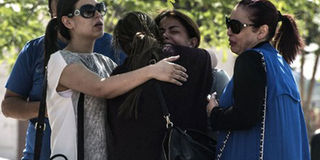Greek, Egyptian officials find plane parts as search goes on

Families of passengers who were flying in an EgyptAir plane that vanished from radar en route from Paris to Cairo on May 19, 2016 react as they wait outside a service hall at Cairo International Airport on the same day. PHOTO | AFP | KHALED DESOUKI
What you need to know:
- Reports of early findings retracted though Greek authorities say a body part and passenger luggage have been seen.
CAIRO, Friday
Egypt’s military found wreckage from the EgyptAir plane that crashed in the Mediterranean as investigators tried to unravel the mystery of why it swerved suddenly and plummeted into the sea.
Search teams spotted personal belongings of passengers and parts of the Airbus A320 about 290 kilometres north of Egypt’s coastal city of Alexandria, the military spokesman said.
Egypt’s aviation minister said on Thursday that a terrorist attack was a more likely cause than technical failure for the plane’s disappearance from radar screens on a flight from Paris to Cairo with 66 people on board.
But French Foreign Minister Jean-Marc Ayrault said there was no indication of why the plane crashed. “We’re looking at all possibilities, but none is being favoured over the others because we have absolutely no indication on the causes,” he told French television.
The tragedy raised fears of a repeat of the bombing of a Russian passenger jet by the Islamic State jihadist group over Egypt last October that killed all 224 people on board.
In Cairo, French and Airbus investigators prepared to meet their Egyptian counterparts to lay the groundwork for their investigation.
The plane disappeared between Karpathos and the Egyptian coast in the early hours of Thursday without its crew sending a distress signal.
Greek Defence Minister Panos Kammenos said the aircraft swerved sharply twice in Egyptian airspace before plunging 22,000 feet and disappearing from radar screens.
Both Egypt and Greece dispatched aircraft and naval vessels on a search mission. They were joined by French teams, while the US sent a surveillance plane.
Egyptian President Abdel Fattah al-Sisi demanded an intensified search for the aircraft after earlier reports by the airline that wreckage from the plane had been found were retracted.
French President Francois Hollande said on Thursday that it was clear the plane had crashed, and authorities in Paris and Cairo opened investigations.
EgyptAir said 15 French citizens were among the 26 foreign passengers on the plane, who also included a Briton and at least one Canadian.
ALSO INCLUDED
The passengers also included two Iraqis and one citizen from Algeria, Belgium, Chad, Portugal, Saudi Arabia and Sudan, as well as 30 Egyptians.
Seven crew members and three security personnel were also on board.
In the United States, White House spokesman Josh Earnest said it was early to definitively say what may have caused the disaster.
The catastrophe also entered the US presidential election campaign, where national security is a prominent issue.
Presumptive Republican presidential nominee Donald Trump said it appeared to be yet another terrorist attack.
“When will we get tough, smart and vigilant?” he asked.
His likely Democratic opponent Hillary Clinton agreed that it “does appear that it was an act of terrorism” and “once again shines a very bright light on the threats that we face from organised terror groups”.
In Athens, the defence minister said a body part, seats and one or more items had been found by the rescue team.
“A few hours earlier we were informed by Egyptian authorities that a body part, two seats and one or more items of luggage where found in the search area north of the coastal city of Alexandria,” Kammenos told a news conference.
He said other aircraft participating in the search had reported more findings though it had not been confirmed.
And in The Hague, Netherlands, the European Space Agency said its satellite spotted a possible oil slick near the site where the plane is believed to have gone down.
“According to the satellite image, the slick was about 40 kilometres southeast of the last known location of the aircraft. The slick is about two kilometres long,” the Netherlands-based ESA said in a statement.
“Since the plane disappeared, ESA and experts have been scrutinising satellite data to see if anything could be found to indicate wreckage of oil floating on the sea,” ESA said.
The slick was spotted at 33°32’ North and 29°13’ East.





